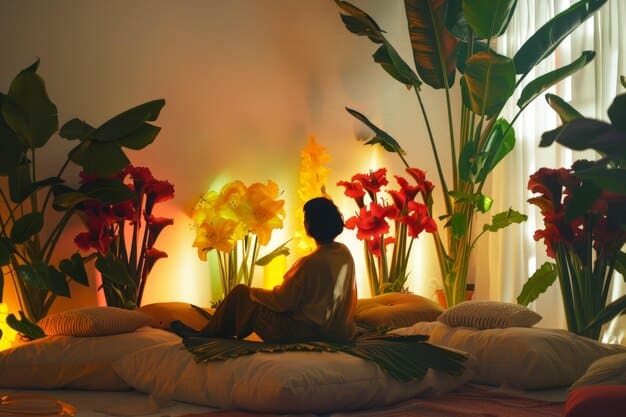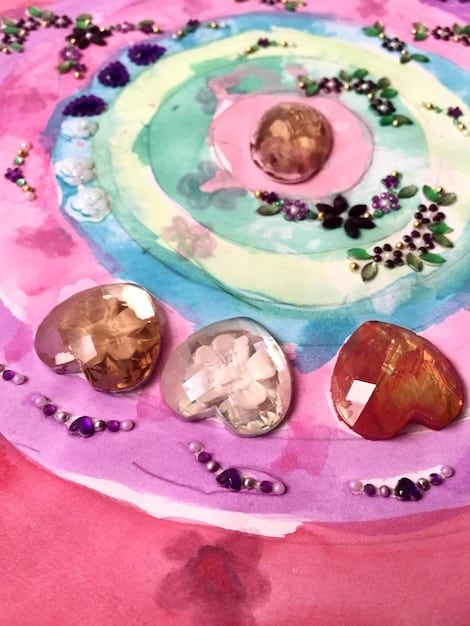Color Meditation: Enhance Mood and Promote Healing

Color meditation is a practice that uses the energy and symbolism of colors to enhance emotional well-being, promote healing, and deepen meditative states, offering a holistic approach to mindfulness.
Explore the vibrant world of color meditation, a powerful technique to harness the energy of colors for enhanced mood and promote healing. This practice combines mindfulness with the therapeutic properties of color to create a transformative meditation experience.
Understanding Color Meditation
Color meditation is a unique form of meditation that focuses on visualizing and connecting with different colors to influence your emotional and physical state. By understanding the specific qualities associated with each color, you can consciously use them to bring balance and healing into your life.
This practice has roots in various ancient traditions and modern psychological studies, all of which acknowledge the profound impact colors can have on our well-being.
The History of Color Therapy
Color therapy, also known as chromotherapy, has been used for thousands of years. Ancient Egyptians, for example, utilized sunlight filtered through colored glass for healing purposes. In traditional Chinese medicine, colors are associated with different organs and elements, guiding practitioners in their treatment approaches.
The Psychology of Color
Modern psychology also recognizes the influence of color on our emotions and behaviors. Studies have shown that colors can affect our mood, energy levels, and even certain physiological processes. For instance, blue is often associated with calmness and tranquility, while red can evoke feelings of energy and excitement.
- Red: Associated with energy, passion, and vitality.
- Blue: Linked to calmness, peace, and relaxation.
- Green: Symbolizes growth, balance, and harmony.
- Yellow: Connected to joy, optimism, and intellect.
Color meditation allows you to tap into these inherent psychological associations, using them to guide your meditation practice and cultivate specific emotional states.
By consciously focusing on colors, you can influence your mental and physical well-being, creating a more balanced and harmonious life.
Benefits of Color Meditation
Incorporating color into your meditation practice can offer a multitude of benefits, ranging from emotional regulation to enhanced creativity. By consciously engaging with colors, you can unlock powerful tools for personal growth and healing.
These benefits are accessible to anyone, regardless of their prior meditation experience, making color meditation a versatile and valuable technique.

Emotional Balance
One of the primary benefits of color meditation is its ability to promote emotional balance. Each color is associated with specific emotions, and by meditating on these colors, you can influence your emotional state.
For example, if you’re feeling anxious or stressed, meditating on blue can help promote a sense of calmness and relaxation.
Stress Reduction
Color meditation can be an effective tool for reducing stress. The act of focusing on a specific color helps quiet the mind, allowing you to release tension and anxiety.
Regular color meditation practice can lead to a more grounded and peaceful state of mind, even in the face of daily stressors.
- Improved Mood: Colors like yellow and orange can uplift your spirits and bring a sense of joy.
- Enhanced Creativity: Visualizing vibrant colors can stimulate your imagination and foster creative thinking.
- Increased Self-Awareness: Paying attention to your reactions to different colors can provide insights into your emotional patterns.
Through consistent practice, color meditation can help you develop a deeper understanding of yourself and your emotional landscape.
This increased self-awareness can empower you to make more conscious choices in your life, leading to greater overall well-being.
How to Practice Color Meditation
Setting up a comfortable and peaceful environment is essential for effective color meditation. This will help you focus and fully immerse yourself in the practice. The specific steps you take can be tailored to your individual preferences and needs.
Start with a quiet space, free from distractions, and follow these steps to begin your color meditation journey.
Preparing Your Space
Choose a quiet and comfortable space where you won’t be disturbed. Dim the lights or use soft, natural lighting. You can also incorporate elements that represent the color you plan to meditate on, such as colored candles, fabrics, or artwork.
Creating a serene environment can significantly enhance your meditation experience, allowing you to connect more deeply with the colors.
Basic Steps for Color Meditation
After preparing your space, follow these basic steps to guide your meditation:
1. Sit comfortably or lie down in a relaxed position.
2. Close your eyes and take a few deep breaths to center yourself.
3. Visualize the color you want to meditate on. Imagine it filling your entire field of vision.
4. Focus on the qualities associated with the color. Feel the emotions and sensations it evokes within you.
5. Continue to breathe deeply and allow the color to permeate your being.
6. When you’re ready, gently bring your awareness back to your surroundings, carrying the energy of the color with you.
Guided Color Meditation
If you’re new to color meditation, guided meditations can be a helpful way to get started. There are many resources available online, including audio recordings and videos that guide you through the process.
These guided sessions often provide detailed visualizations and affirmations, making it easier to connect with the colors and experience their benefits.
Regular practice of color meditation can lead to profound insights and transformative experiences, fostering a deeper connection with yourself and the world around you.
Colors and Their Meanings in Meditation
Each color carries unique energies and associations that can influence your meditation in distinct ways. Understanding these qualities allows you to consciously choose colors that align with your intentions and needs.
Whether you’re seeking relaxation, energy, or healing, selecting the appropriate color can amplify the benefits of your meditation practice.

Red: Energy and Vitality
Red is often associated with energy, vitality, and passion. Meditating on red can help boost your energy levels, increase motivation, and ignite your inner fire. This color is particularly useful when you’re feeling lethargic or uninspired.
Be mindful of using red in moderation, as excessive exposure can sometimes lead to feelings of aggression or restlessness.
Blue: Calmness and Peace
Blue is linked to calmness, peace, and tranquility. Meditating on blue can help reduce stress, lower anxiety, and promote a sense of inner peace. This color is ideal for times when you’re feeling overwhelmed or stressed.
Blue can also enhance communication skills and foster a deeper connection with your intuition. It’s a powerful color for promoting relaxation and mental clarity.
Green: Balance and Harmony
Green symbolizes growth, balance, and harmony. Meditating on green can help restore balance in your life, promote healing, and foster a sense of connection with nature. This color is particularly beneficial when you’re feeling disconnected or out of sync.
Green can also boost your immune system and promote physical healing, making it a valuable color for overall well-being.
Yellow: Joy and Optimism
Yellow is connected to joy, optimism, and intellect. Meditating on yellow can uplift your spirits, boost your confidence, and enhance your mental clarity. This color is perfect for times when you’re feeling down or lacking motivation.
Yellow can also stimulate creativity and promote a positive outlook on life, making it a valuable color for personal growth and development.
Experiment with different colors to discover how they uniquely affect you and which ones best support your specific goals.
Regular engagement with color meditation can lead to a deeper understanding of yourself and the world around you, fostering a more balanced and fulfilling life.
Integrating Color Meditation into Your Daily Life
Incorporating color meditation into your daily routine is easier than you might think. Even a few minutes of focused visualization can make a significant impact on your emotional and mental state. There are various ways to integrate this practice into your lifestyle, whether at home, at work, or on the go.
Consistency is key to experiencing the full benefits of color meditation, so find strategies that work for you and stick with them.
Short Daily Sessions
Start with short, focused sessions of just 5-10 minutes each day. Choose a color based on your current needs and spend a few moments visualizing it and feeling its associated emotions.
Even these brief moments of color meditation can help reduce stress, boost your mood, and enhance your overall well-being. Consistency is more important than the duration of the sessions.
Using Color in Your Environment
Surround yourself with colors that support your desired emotional state. Wear clothing in colors that uplift you, decorate your workspace with calming hues, or incorporate colored lighting into your home.
Creating a color-rich environment can amplify the effects of your color meditation practice, providing ongoing support for your emotional and mental well-being.
- During Breaks: Take a few minutes during your work breaks to visualize a calming color, such as blue or green.
- Before Bed: Meditate on a relaxing color like lavender or indigo to promote restful sleep.
- In the Morning: Start your day with a vibrant color like yellow or orange to boost your energy and motivation.
By integrating color meditation into various aspects of your daily life, you can create a powerful and holistic approach to well-being.
Regular practice can lead to lasting positive changes, fostering a deeper connection with yourself and the world around you.
Advanced Techniques in Color Meditation
Once you’ve mastered the basics of color meditation, you can explore more advanced techniques to deepen your practice and enhance its benefits. These techniques involve more nuanced visualizations and a greater focus on sensory details.
Experiment with these advanced methods to discover new dimensions of color meditation and unlock its full potential.
Chakra Color Meditation
Chakras are energy centers in the body, each associated with a specific color. Chakra color meditation involves visualizing these colors at their corresponding chakra points to balance and harmonize your energy flow.
This practice can help release blockages, promote healing, and foster a greater sense of overall well-being.
Combining Colors
Experiment with combining different colors in your meditation practice. For example, you might visualize green and blue together to promote both balance and calmness.
Blending colors can create unique emotional and sensory experiences, allowing you to tailor your meditation to your specific needs and intentions.
- Sensory Visualization: Engage all your senses when visualizing the colors. Imagine the texture, scent, and sound associated with each color.
- Affirmations: Combine color meditation with positive affirmations to reinforce your intentions and amplify the benefits of the practice.
- Mantra Repetition: Repeat a mantra that resonates with the color you’re meditating on to deepen your focus and enhance its effects.
By incorporating these advanced techniques into your color meditation practice, you can unlock new levels of awareness and transformation.
Continued exploration and experimentation can lead to profound insights and lasting positive changes in your life.
| Key Point | Brief Description |
|---|---|
| 🧠 Understanding Colors | Each color has unique emotional and physical effects. |
| 🧘 Practicing Meditation | Visualize colors to enhance your meditative state. |
| 🌈 Daily Integration | Incorporate colored environments and visualizations daily. |
| ✨ Advanced Techniques | Explore chakra colors and blended visualizations to deepen the meditation. |
FAQ
▼
Color meditation is used to enhance emotional well-being, reduce stress, boost creativity, and promote healing by focusing on the unique properties and energies of different colors during meditation.
▼
A color meditation session can last anywhere from 5 to 30 minutes, depending on your experience and preference. Shorter sessions are effective for beginners, while more experienced meditators may prefer longer durations.
▼
Yes, color meditation can be a valuable tool for managing anxiety. Focusing on calming colors like blue or green can help quiet the mind, reduce stress, and promote a sense of peace, thus alleviating anxiety symptoms.
▼
No, special equipment is not necessary for color meditation. You can simply use your imagination to visualize the colors. However, some people find it helpful to use colored lights, fabrics, or objects to enhance their practice.
▼
For best results, practice color meditation regularly, ideally daily. Even short sessions of 5-10 minutes can lead to noticeable improvements in your emotional well-being and overall sense of calm over time.
Conclusion
Color meditation offers a simple yet profound way to enhance your mental and emotional well-being. By understanding the unique properties of colors and integrating them into your meditation practice, you can unlock a powerful tool for healing, balance, and personal growth. Whether you’re new to meditation or an experienced practitioner, exploring the world of color can add a vibrant new dimension to your mindfulness journey.





